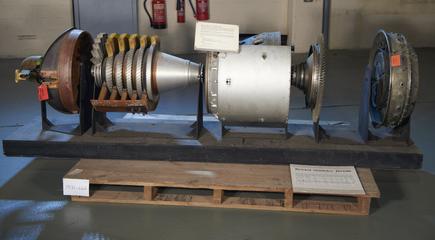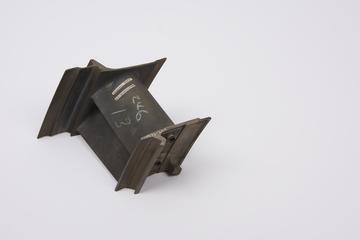
De Havilland Controllable-Pitch Airscrew (1939)
- Made:
- 1939
Sectioned working example of a de Havilland Controllable Pitch Airscrew, together with one sectioned constant speed control unit and one descriptive drawing framed and glazed
Although the advantages of controllable-pitch for an airscrew were recognised many years ago, it was not until the period 1936/39 that the practical difficulties were overcome and a satisfactory and reliable controllable-pitch airscrew was evolved. By the use of such an airscrew the loss of engine power, which results from the take-off and climb of an aeroplane, is avoided. In this two-bladed, partly sectioned example, the angular setting of the blades is controlled hydraulically by making use of the engine oil-pressure system.
The controllable-pitch mechanism is operated from the cockpit control which is connected with a two-position valve. Backward motion of the control moves the valve into a position which allows the engine oil to be forced into the airscrew from the oil pump. The oil passes through a collector ring into the airscrew shaft and thence into the pitch operating cylinder. The oil being trapped by the cylinder head, compels the cylinder to slide forward along the fixed piston. The forward motion of the cylinder is transmitted by the bearing shafts to the cam slots in the counterweight brackets, causing the latter to rotate inwards, towards the crankshaft axis, against centrifugal force. Since the brackets are attached to the airscrew blades by the four index pins, the blades rotate to assume the low or fine pitch position, Opposite movement of the cockpit control allows the pol to return from the airscrew cylinder to the engine crankcase and the sequence of operations is reversed, The centrifugal force of the counterweights causes the brackets to travel away from the airscrew shaft axis and the resultant action forces the cylinder assists the oil to flow back in to the crankcase. Release of oil pressure, therefore, causes the airscrew blades to occupy the coarse or high pitch position.
This airscrew is 6.5ft in diameter and has a standard angularity of 9 degrees, which satisfies most normal requirements, and is intended for use with engines up to 250 h.p. Its weight is approximately 70 lb. To meet the special needs of high-performance military and racing aircraft, however, limits of 20 degrees angularity for the larger types and 14 degrees for the smaller types have been introduced. To enable both the airscrew and the engine to operate continuously at the most efficient speed whatever the altitude, a constant-speed governor has been devised.
Details
- Category:
- Aircraft Propulsion
- Object Number:
- 1939-230
- type:
- section
- credit:
- De Havilland Aircraft Co. Ltd.




